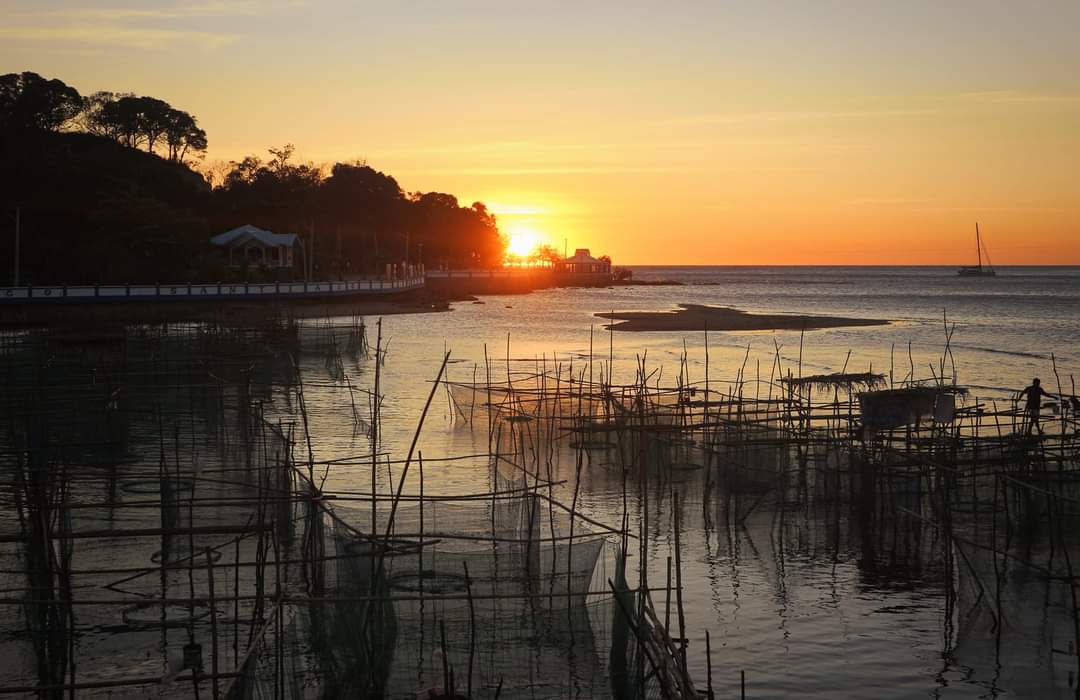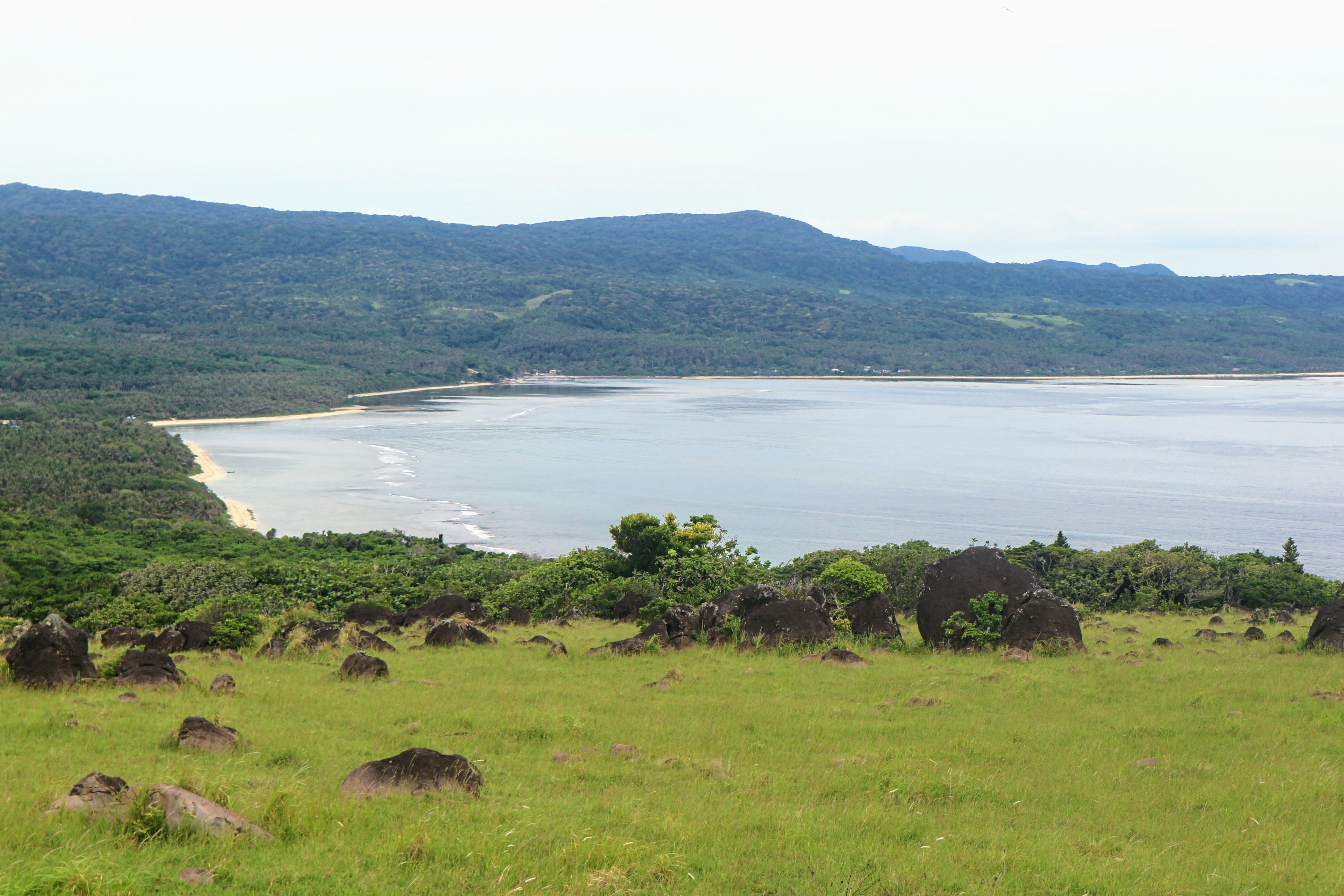ILOCANDIA: THE NARRATIVE OF THE DRAMATIC SUNSET THAT NEVER FADES
📌 Ilocos Sur, Philippines
EACH of the Philippines' province or region has a distinct feel: the landscape, the natural environment, the people and their culture.
Far north of Manila, on the western seaboard of Luzon Island, lies the Ilocandia, a narrow strip of land packed between the Cordillera mountains on the east and the azure, blue waters of South China sea on the west.
 |
| The best sunsets in the Philippines is on the western coast of the country (Sabangan River, Santiago) |
The Ilocandia, known administratively as Region 1, comprises the all first-class, Iluko-speaking provinces of Ilocos Norte, Ilocos Sur, La Union and Pangasinan. The Ilokanos, without fear and without prejudice are welcoming people marked by their ability to absorb almost any kind of outside influence. Perhaps, it was that kind of hospitality that allowed the Ilocandia to immediately embrace and eventually accept Spanish cultural heritage when subsequently Juan de Salcedo established his bastion at Ciudad Fernandina, now Vigan, Ilocos Sur. Up to this day, Vigan retains a retrospective, Spanish feels of lovely streets of Castilian houses and architecture; the most intact Spanish colonial place in the Philippines that made the city a celebrated UNESCO World Heritage Site.
 |
| The most intact Spanish colonial settlement in the world is found in Vigan, Ilocos Sir, a UNESCO World Heritage Site |
The resplendent province of Ilocos Sur is arguably one of the most if not the most Spanish-colonized province in the country; the remnants of Hispanic colonization are seen on the sheer number of churches, fortifications and architectures found in nearly all of its towns - many of which, named after catholic saints and martyrs or atleast derived from Spanish terms.
Among those remnants, churches are Spain's most prominent architectural legacy built in baroque configuration and fortress-like walls and butress; also being the century-old Vigan Cathedral (1575), the San Juan de Sahagun Church also locally known as Candon Church (1695) and the Santa Maria Church built in 1765, a UNESCO declared heritage site, the most remarkable religious tourist spots not to miss on your map.
 |
| Santa Maria Church, one of the only four UNESCO baroque churches in the Philippines |
Moreover, Santa Maria boasts not only man-made attractions but also natural wonders alike. A coastal town embedded between the Sulvec Bay, part of the South China Sea and the western edge of the Cordilleras, Santa Maria is renowned with the majesty of Pinsal Falls characterized by a landscape like that of bright nature painting; spattered yellow, white, orange, green and brownish red hues in a canvas engulfed by the intertwined tentacles of a thick rainforest near the neighboring border of Abra province.
The climate in the Ilocandia Region is comparable to the Mediterranean during summer; plenty of sunny days that are not too hot that make an ideal long beach-ramping to its pristine shores as early as November that could last until early June. Its climate is perfect for growing the high-valued Virginia tobacco, one of the province's top source of income where Candon and Santa Cruz excel being the largest producers of the crop.
 |
| Kagutungan Falls in Santa Cruz, a type of block waterfall |
Going south of Vigan is the tranquil seaside town of San Esteban, a historical municipality with a scenic coastline and a protected rich marine ecosystem. The Moro Watch Tower known as "Bateria" is a lasting sentinel against the marauding Moro pirates during the Spanish era and is considered to be the oldest landmark in San Esteban with a recognition from the National Historical Institute as an authentic, historical site. In 1944, the American forces with their attack submarine USS Gar docked in San Esteban Cove, landed at Apatot Beach as part of the eventual Philippine liberation against the stiff Japanese Army.
Not far from the landing site is the Layap Rock formation along the coast of Bateria. It is a gigantic hard-rock, almost spherical in shape and is believed to be a meteorite with magical stories knitted from the tongues of Ilokano generation.
The designated marine protected areas and the Fish Sanctuary of San Esteban allow its aquatic ecosystem to thrive well with excellent capacity. A spectacular shallow reef with highly varied life forms teeming incessantly beneath the surface is a dive site to behold when you visit this tiny town.
 |
| San Esteban Marine Protected Area rich in corals and sea grasses |
Like said, the Ilocandia's super-fine weather resemblant to southern Europe is the inspiration behind the truly little Santorini of the Philippines - the luxure, world-class Vitalis Villas Resorts in the town of Santiago. The blue and white motiff of the Greek architectural style perched majestically on a cliff overlooking the expansive Santiago Cove elicits that of what can be found in Santorini, Greece, Azenhas Do Mar, Portugal, Ibizà, Spain or in Positano, Italy.
The municipality of Santiago is perhaps the most tourist-visited place in Ilocos Sur next to Vigan. Its white beaches from Butol, Gabao and Ambucao draws local tourists and passers-by while the tranquility and night life of Sabangan Beach at Santiago Cove beacons international visitors. Ilocos Region faces west and so, one of the best coasts in the country for sunset viewing can be found in this cove, near the Sabangan River where it meets the fading sun and the calm sea in a prismatic shimmer of brilliant yellow-orange horizon.
Sillouettes of docking boats and the numerous tangles of fish pens translate the afternoon scene so dramatic.
 |
| Santorini of the Philippines, Villa Vitalis, Santiago during a fine, Mediterranean feels weather |
The long coastline of Ilocos Region is located almost 90 degrees parallel to the prime meridian of the globe, creating the most perfect, dramatic painting of sunset in the country.
The Mapisi Rock Formation (Biak Na Bato) displays the rugged, northern parts of Santiago. This collosal boulder of coral rock is a work of geologic forces and perpetual sea barrage that transcended before time; testamenting that nature is still the greatest landscape architect that never stops jaw-dropping the adventurers. Mapisi is an Iluko word which means "being cut or sliced", as the formation presents a split gargantuan rock with a cavern that sits along the white sand beach giving an extremely beautiful sight and background.
 |
| The unforgettable sunset viewing at Santiago, Ilocos Sur on sight a grounded Chinese barge |
Still going south from Santiago is the bustling, historical city of Candon. It is where the local hero Isabelo Abaya declared the victory of the Ilokanos against the Spaniards, hence the famous battle cry "Sigaw ng Candon" (Ikkis Ti Candon) commenced in 1898. Not far from the historical marker of Sigaw ng Candon Monument is the San Juan de Sahagun Church erected in 1695, showcasing an intricate octagonal belfry. The church's interior highlights a curving ceiling of a heavenly painting and its 46-meter long canvas art of the Mysteries of the Holy Rosary is also believed to be the longest religious painting in the Philippines. Around and nearby the church are numerous preserved Spanish houses that adorn every alleys of the city's central business district.
Candon City doesn't have much aesthetic or rustic beach offerings like those found in Santiago or Cabugao other than the Darapidap Beach which is said to be the widest seashore in the entire Ilocos Sur and is only good for morning and sunset strolls along its brick-paved sea boulevard recognized by its Lighthouse but its lackness of such doesn't rid the city of its enormous economic power, owing partly to its profitable, luscious kalamay production and immense tobacco plantations that gained the city the reputation of being the Tobacco Capital of the Philippines.
 |
| Candon, the place where Philippine Independence was declared that lasted only 2 days known as the "Sigaw ng Candon" |
The southern part of Ilocos Sur is generally mountainous yet, it is this feature that rewards the town of Santa Cruz the bounties of the tropical rainforest of the Cordilleras. One of which is the voluminous Kagutungan Falls that features giant strangler figs above its platform with their dangling roots soaked, hanging on the deep basin of the waterfalls. Together with Candon, the town of Santa Cruz, one of the largest municipalities of Ilocos Sur constitutes the largest tobacco production in the Ilocos Region owing to its near coastal plains dedicated to Virginia's cultivation.
Northeast of Santa Cruz, nearer to the mountain chain of the grand Cordillera is the small town of Salcedo. Already more tropical than the rest of the province since it faces far away from the sea, Salcedo takes pride of the idyllic mountainside where one can get an unwinding serenity at Bago Mountain Resort. Fresh from Mount Madarang, the natural spring water fills up the man-made pools with continuously running and refreshing water. Hugging the resort is the white water Buaya river meandering from the inner Cordilleras where trekkers and adventure-buffs could try to conquer, leading them to the Mount Madarang and falls and eventually into the historical Tirad Pass, the last stand of the young but brave Gen. Gregorio del Pilar who killed in that battle while protecting Gen. Emilio Aguinaldo against the pursuing American soldiers.
 |
| Sangbay Falls in Salcedo, meaning "welcome" |
With steep terrains and higher rainfall than the coastal parts of the province, it is absolutely the countless waterfalls that stand out as the most spectacular inland water feature not just in the province but anywhere else in the Philippines; especially those surrounded by lush, brooding greens of the impenetrable tangles of vegetation. The rushing mountain river tumbling time and again over a precipitous cliff edge creating a stunningly striking vertical white ribbon of water dropping on a clear pool basin is the description of one of Ilocos Sur's tallest waterfalls, the Sangbay Falls. The falls lives up to its name, meaning "welcome", allowing every nature tripping, aside from beach-bumming so fantastic in Ilocos Sur.
The almost always friendly approach and warm welcoming of the Ilokanos are without any doubt, the signature descriptions of the Ilocandian human landscape. Of course the "pinakbet", a concoction of shrunk vegetables in a fish paste (bugguong) and the misunderstood concept against them being "kuripot" (thriftiness) as part of their cultural fabric etched in the minds of the uninformed are both attributed to the saluyot-loving Ilokanos.
 |
| A typical Ilokana woman of modesty and class |
But regardless of what you think about them, I could not argue more until you experience the dramatic sunsets of Ilocos that never fade, the turning back of time at Vigan and the pleasantness of "bagnet", "dinengdeng" or "inabraw", when you attend a "punsion" or a "boda" festivities in any town of Ilocos Sur.
Agbiag dagiti Ilokano!
#IlocosChronicles #ilocossurtourism #IlocosSur #CandonCity #BeyondTheValley




































